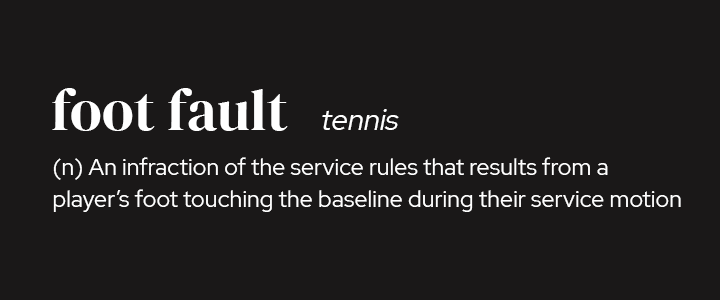Check out my custom vibration dampener
Foot Fault in Tennis
Foot Fault (noun) [foo t fawlt]
In this article, we’re discussing foot faults, including what they are, why they matter, and how to prevent them.
Article Contents
Click below to jump to a section
Tap below to jump to a section
What is a Foot Fault?
Examples
Foot Fault Controversy
Reducing Foot Faults
Wrapping Up
New to TennisCompanion?
Create a free account and explore my latest videos below
What Is A Foot Fault In Tennis?
A foot fault occurs when a server’s foot touches any part of the baseline, or the imaginary extension of the center mark. For a foot fault to be called, any part of the server’s foot must touch any part of the baseline during the serving motion. This is according to Rule 18 of the official ‘Rules of the Game.’
Servers are permitted to ‘slight’ movements of the feet during a serve, but no large movements that might gain them an unfair advantage. This could include running along the baseline to create a different angle.
Examples Of ‘Foot Fault’ In A Sentence
I overstepped the baseline, so I rightly had a foot fault called against me.
Watch out for the foot fault – I can see that you’re regularly brushing the baseline with your feet while you serve.
Why Can Foot Faults Be Controversial?
Foot faults are called by line judges who watch the server’s feet while they are in motion. This can be a pretty controversial fault to call, as demonstrated by the infamous foot fault call against Serena Williams in her 2009 US Open semifinal against Kim Clijsters.
Williams was facing a crucial point at 15-30 down to keep her hopes alive, but the line judge called a foot fault on her second serve.
For more information on how the scoring system works, see our article on how to keep score in tennis.
Foot faults are penalized in the same way as missing a serve would be, so Williams lost the point, and the score moved to 15-40 – break and match point to Clijsters.
Regrettably, Williams was incensed by the call and began berating the match officials; she later apologized. This meant that she was docked another point, therefore handing the match to Clijsters.
Casual observers of the game of tennis might be confused as to why Williams lost her cool over a simple officiating call. However, the fact of the matter is that foot faults are called very inconsistently, meaning that players regularly overstep the line on serve, but are not penalized for it.
Beginners and intermediate players often touch the baseline during serve, even though they may be unaware of it. Of course, it is challenging for the opponent in a typical friendly park game to bring up the subject of a foot fault, being on the other side of the court.
Considering that foot faults are called so sporadically, it’s easier to understand Williams’ frustration at being penalized during such a crucial point in the match.
At the time, a former line judge named Jeff Ponder explained that the line judge would have been correct in her call. He also went on to say that foot faults cannot be challenged or reviewed, and this is still the case in 2019.
Former serve-and-volleyer Justin Gimelstob gave his opinion: “95% of foot faults are not called”. That is why they tend to incite plenty of anger when they are flagged up.
How Can I Reduce Foot Faults In My Own Game?
If it sounds like a nightmare to be penalized for a foot fault at a crucial time during your game, then you’d be right. Even if there are no line judges, a particularly observant opponent could start to call you up if you regularly cross the baseline during your serve.
Serve-and-volleyers are often more likely to commit foot faults due to their reliance on rushing the net immediately after serving to take control of the point.
Before concentrating on foot faults, you want to make sure that everything else is in check with your service motion. If you tend to commit a double fault, these need to be minimized to increase your chances of winning matches.
Double faults most frequently occur when the server fails to land their first and second serves inside the service box.
In fact, double faults can be paralyzing. Marc Rosset holds the undesirable honor of most double faults in a single professional match at 26. He, of course, lost the match.
Moving back to the foot fault, let’s take a look at a few ways you can work on eliminating this frustrating fault from your game:
- One of the most simple solutions is to move backward in your serve. Of course, even moving back a few inches can make a difference to your serve, so make sure to practice enough to accommodate the change.
- Practice serving with a spare racquet on the ground in front of your feet, covering the edge of the baseline. If you kick the racquet during your serve, you will know when and with which foot you are committing a fault.
- Refine your serve and toss action. TennisCompanion has some great tips and drills for getting it just right! If everything goes well, your serving action should resemble the trophy pose.
- Find a friend or relative to record your service action on your phone. Watching your serve on replay, as cringeworthy as you may find it, really helps you to pinpoint the parts of your service motion that need work.
If you find yourself on the opposite side of the net to someone who is consistently making foot faults, it can be tough to know how to handle the situation. For the majority of tennis players, line judges will not be present, so you just need to use common sense.
Most casual players are happy to let foot faults slide; there’s no need to become known as “the one who pulls you up for every foot fault.”
However, ask yourself if your opponent appears to be consciously using foot faults to their advantage, and rushing the net after each serve. If they are manipulating foot faults to their benefit, you are within your rights to challenge them on their actions.
Wrapping Up
Most professionals are likely to be enraged if a line judge deems their foot to have brushed the baseline during their serve – mostly because of the fact that many of these faults are overlooked.
At the same time, most players will feel angry with themselves – it is an unnecessary fault that is easily correctable with some minor changes to the serving motion.
Home > Terminology > Foot Fault in Tennis
Play Better Tennis
Improve your game alongside our community of tennis players
Why join?
Discussion Boards
Join the conversation with other members of the community.
5 Point Friday
Read our weekly recap of the 5 most interesting things we dig up in tennis.



Leave a Reply
Want to join the discussion?Feel free to contribute!